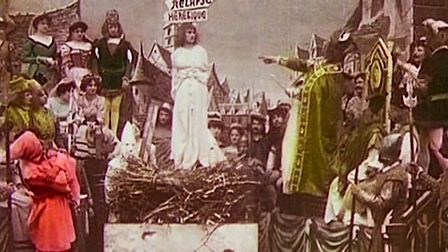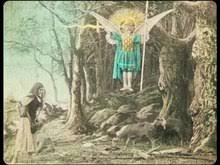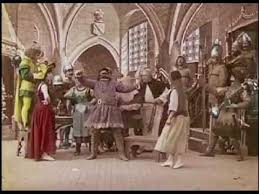
- Details:
- Directed by Georges Méliès
- Produced by Georges Méliès
- Written by Georges Méliès
- Released 1900
- Country France
- Duration 13 minutes
- Cast Jeanne Calvière, Jeanne d’Alcy, and Georges Méliès
Break Down:
Jeanne d’Arc (Joan of Arc) takes place in the village of Domrémy in France. A young woman who lives in the town named Joan is visited by three various saints, Saint Michael, Saint Catherine, and Saint Margaret. These saints tell her she needs to fight for her country. She decides to listen to the saints against the wishes and pleads of her family. She heads to Vaucouleurs and meets up with Captain Robert de Baudricourt. After some convincing, the Captain allows her to fight with the French soldiers and command them as well. During a siege, Joan is taking as a prisoner by the Anglo-Burgundians and has more visions while she is in prison. Joan is considered a heretic and burned at stake. While the fire at the stake is being stoked, the wood carrier dies from the fumes. The short ends with Joan ascending to heaven, where she is greeted by the Saints and God.
Jeanne d’Arc is a short that was released in the year 1900. It is based on the life of Joan of Arc. Despite this being a short silent film, it does a fantastic job of pulling one in and forcing an emotional response. The music is relatively consistent the entire time. However, there are times when it changes its tempo to match the scenes being depicted. Although Jeanne Calvière is the star of the short, playing Jeanne d’Arc (Joan of Arc), writer and director Georges Méliès plays seven separate roles. He plays Jeanne’s father, her uncle, Robert de Baudricourt, a beggar, a soldier, one of the jailers, and the wood carrier at the execution.

Méliès was a leader in the film industry and was well known for his special effects, which are evident in this early film. He popularized techniques like substitution splices, multiple exposures, time-lapse photography, dissolves, and hand-painted color scenes. The hand-painted color scenes really help make Jeanne d’Arc stand out from other silent films of the time. There are a few scenes that really come together because of the added color. The one that sticks out the most is the final few shots of the short. The one where Jeanne is being burned at the stake. The added red and orange color in the fire helps to drive home the fire’s size and heat that causes the wood carrier to die. The final shot is of Jeanne ascending to heaven, and the color in this scene also helps to deliver the message of what is playing out. In the parade at Orléans, Méliès had the cast walk from left to right across the screen and then circle back around off scene and cross again, giving the illusion of over 500 people being in the parade.
Méliès wanted to ensure that viewers understood Joan’s status as a national hero of France and her being a martyr to the people. This is demonstrated when Joan first appears on the screen, herding a flock of sheep. This is a type and shadow of how Joan will eventually lead the French soldiers. At the end of the short, Joan enters into the kingdom of heaven and is greeted by the Saints and God. This signifies Joan’s status as being suitable for sainthood. 20 years after the film was released, the Catholic church agreed with Méliès depiction of Joan. It officially canonized her solidifying her as a Saint.
The film was an excellent success for Méliès and second only to his film Cinderella. It was shown all over France, Montreal, Havana, and England. It was also offered all over the United States by the Edison Manufacturing Company; only the prints being sold in the US were all pirated duplicates. This became such an issue for Méliès that he opened an American branch of his company in New York. The film disappeared and was thought to have been lost forever, until 1982 when a hand-colored print was discovered. The print, however, was missing the first scene.
Watch “Jeanne d’Arc (1900)” on TheLastPicture.Show
Written exclusively for TheLastPicture.Show by Jacob Ruble
Disclosure: The links on this page are “Affiliate Links” and while these are shown at no costs to our viewers, they generate commissions for our website(s)

